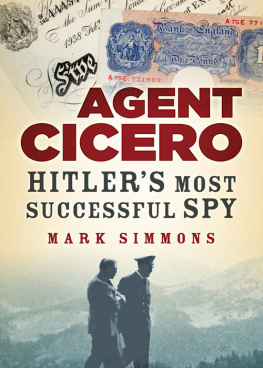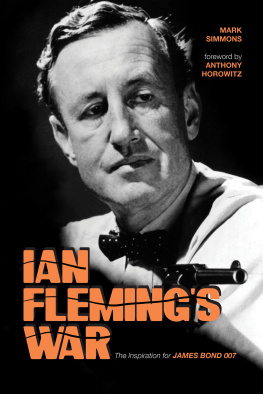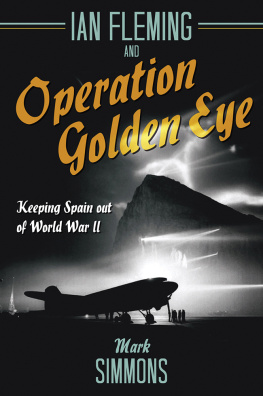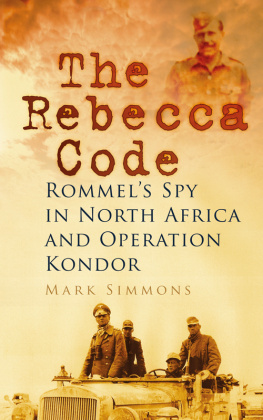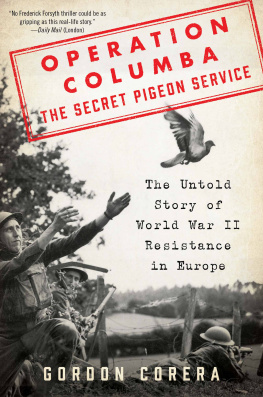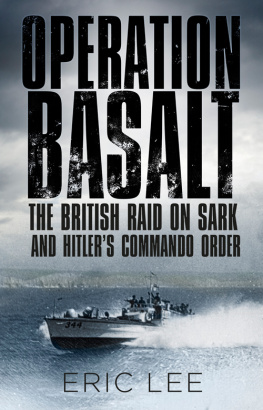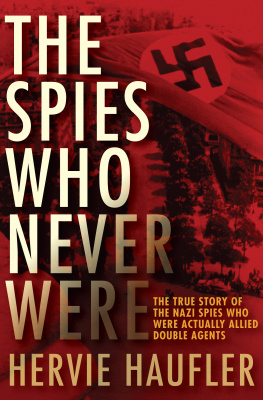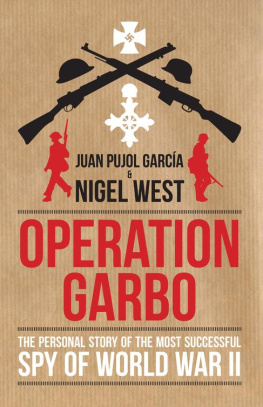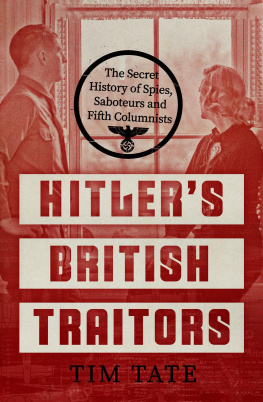
Other books by Mark Simmons:
A Crack in Time: A Search for the Echoes of the American Civil War (2004)
From the Foam of the Sea (2007)
The Serpent and the Cross (2010)
The Battle of Matapan 1941: The Trafalgar of the Mediterranean (2011)
The Rebecca Code: Rommels Spy in North Africa and Operation Kondor (2012)
Room 39 and the Cornish Legacy (2013)
Dedicated to the memory of that consummate actor, James Mason.
What is morally wrong can never be advantageous, even when it enables you to make some gain that you believe to be to your advantage. The mere act of believing that some wrongful course of action constitutes an advantage is pernicious.
The enemy is within the gates; it is with our own luxury, our own folly, our own criminality that we have to contend.
Memory is the treasury and guardian of all things.
Marcus Tullius Cicero, 106 BC 43 BC
CONTENTS
The story of Germanys most successful spy came to my attention again, after many years, while engaged in research for my previous non-fiction book, The Rebecca Code: Rommels Spy in North Africa and Operation Condor (Spellmount, 2012). In the book, two German spies, Johannes Eppler and Heinrich Sandstette, are taken by the famed explorer Count Lszl Almsy across the Western Desert and into Cairo to spy on the British Eighth Army HQ. To fund their mission, the Abwehr agents are supplied with thousands of pounds sterling, although, unbeknown to them, it is all counterfeit. The Albanian Elyesa Bazna, who later became Agent Cicero, was paid with the same forged money, to the tune of some 300,000, all coming from the Nazi counterfeiting scheme named Operation Bernhard. The Cicero case was something I felt needed looking at again for several reasons.
It had first come to my attention with the feature film Five Fingers , starring James Mason as Cicero. I felt the character, portrayed so well by Mason, was a faithful depiction after we were told this was a true story. However, when I came to read L.C. Moyzischs book, Operation Cicero (1950), on which the film was loosely based, it was apparent that Five Fingers , as entertaining as it was, was a highly distorted version of the real story. Rereading my battered 1952 Readers Union edition of Operation Cicero , it became obvious the story needed updating, as many secret British and American files on the subject are now open to the public.
Moyzischs book was the first to tell the story; he had been the main link between the Germans and agent Cicero. He is at times guilty of overstating his position and denying mistakes, but then this is a very human frailty. In a postscript to later editions, Franz Von Papen, German ambassador in Turkey and once chancellor of Germany, supports his account.
Five Fingers was brought out in 1952 and Von Papen released his memoirs that same year; it has a whole chapter on the Cicero case and much else that bears on it. Elyesa Bazna was the last to release his account in 1961, in a veiled attempt to embarrass the German government into compensating him for the Nazi regimes fraud of having paid him with counterfeit money. He does exaggerate his abilities at times, often wildly, and is guilty of other flights of fantasy.
The British MI5 and MI6 files were released to the public in 2006, while the American CIA released their secret Footnote to Cicero rather earlier in 1994. It was my aim, as it had been with The Rebecca Code , to bring together these three eyewitness accounts by Moyzisch, Von Papen and Bazna, along with the official files, and tell the true story of Operation Cicero.
Secondary sources that have been most useful include Sir Hughe Knatchbull-Hugessens memoirs, Diplomat in Peace and War (1949), although, due to the British Official Secrets Act, Knatchbull-Hugessen does not mention Cicero. However, it does provide a portrait of the times and much pertinent information on the delicate situations he was handling.
Walter Schellenbergs The Memoirs of Hitlers Spymaster (2006), first published as The Schellenberg Memoirs: A Record of the Nazi Secret Service (1956), covered his involvement in the Cicero case, and provided a broader view of the world of Nazi intelligence services and the German High Command.
Anthony Cave Browns impressive Body Guard of Lies (1975) gave me a flavour of much good background material, although without the benefit of secret files his conclusions are questionable.
David Kahns The Code Breakers (1968) and Hitlers Spies (1978) supplied many more details.
Richard Wires The Cicero Spy Affair (1999) is one of the few books entirely devoted to the Cicero case, and is an excellent academic treatment.
Adrian Weales The SS: A New History (2010) is a good guide on details of the SS, which he has made his speciality.
I was particularly pleased to obtain a copy of Adolf Burgers book, The Devils Workshop: A Memoir of the Nazi Counterfeiting Operation (2009), and even more so to find it was signed by the author: a clear link to the past and the Cicero case.
I am grateful to staff at Bletchley Park, and even more so to see a room now devoted to the Battle of Matapan after I had written a book on the subject, The Battle of Matapan (2011). I thank the staff of the Public Records Office; Dorothy J. Heatts at the Central Intelligence Agency Library; the United States National Archives and Records Administration; the United States Navy Historical Department; the Imperial War Museums; and the Opel Centre, Berlin.
I am hugely indebted to the following people who have given freely of their time: Shaun Barrington, my commissioning editor at The History Press, for his enthusiastic support for the project; Group Captain L.E. (Robbie) Robins CBE AE** DL, another grand supporter, for reading an early draft and making many excellent comments and suggestions; John Sherress, fellow author and good crutch when the going got tough; and my magazine editors, Iain Ballantyne, John Mussell and Flint Whitlock, for continued support.
Finally, as always my wife, Margaret, gave her wholehearted support in the nuts and bolts of building a book, with proofreading, index-compiling, work on the maps, and finding her way through the labyrinth of strange and unfamiliar names, and my creative misspelling of them. Thanks to all.
Bazna, Elyesa Albanian/Turkish valet at the British Embassy in Ankara, sometimes known as Diello/Ilya. Spied for the Germans under the codename Cicero.
Dulles, Allen Welsh American OSS agent in Switzerland. Later director of the CIA.
Garcia, Juan Pujol Spanish double agent under the British codename Garbo and Abwehr codename Arabel.
Kaltenbrunner, Ernst German SS General. Chief of the RSHA.
Kapp, Cornelia German translator/secretary, also known as Nele or Elisabet. Spied for the OSS at the German Embassy in Ankara.
Knatchbull-Hugessen, Sir Hughe British ambassador in Ankara.
Menzies, Sir Stewart Graham British head of SIS/MI6, also known as C.
Moyzisch, Ludwig Carl German commercial attach/SD officer at German Embassy in Ankara.
Von Papen, Franz Joseph German ambassador in Ankara.
Ribbentrop, Joachim German Foreign Minister.
Schellenberg, Walter Friedrich German intelligence officer with the SD, later head of the RSHA.
Abwehr | German secret service, meaning defence in German. |
AO | Abwehr officer. |
Bupo | Bundespolize i, the Swiss secret police. |
C | Head of British Secret Intelligence Service (SIS) MI6. |
Camp 020 | British interrogation centre in Richmond, Surrey. |
Next page
